Spatiotemporal Evolution of Water Resource Utilization and Economic Development in the Arid Region of China: A “Matching-Constraint” Perspective
Abstract
:1. Introduction
2. Data Sources and Methods
2.1. Study Area
2.2. Research Framework
2.3. Data Source and Index Selection
2.4. Methods
- (1)
- Gini coefficient
- (2)
- Imbalance index
- (3)
- Growth drag model of water resources
- (4)
- Classification of urban “matching-constraint” types
3. Results
3.1. Matching Analysis of Water Resources Utilization and Economic Development
3.2. Constraint Effect of Water Resources Utilization on Economic Development
3.2.1. Analysis of the Output Elasticity of Factors
3.2.2. Analysis of the Growth Drag of Water Resources
3.3. Status Zoning of Water Resources Utilization
4. Discussion
4.1. Comparison with Previous Studies
4.2. Analysis of Driving Mechanism
4.3. Limitations
5. Conclusions
Author Contributions
Funding
Institutional Review Board Statement
Informed Consent Statement
Data Availability Statement
Acknowledgments
Conflicts of Interest
References
- Gleeson, T.; Wada, Y.; Bierkens, M.F.P.; Van Beek, L.P.H. Water Balance of Global Aquifers Revealed by Groundwater Footprint. Nature 2012, 488, 197–200. [Google Scholar] [CrossRef]
- Yang, F.; Wang, D.; Zhao, L.; Wei, F. Efficiency Evaluation for Regional Industrial Water Use and Wastewater Treatment Systems in China: A Dynamic Interactive Network Slacks-Based Measure Model. J. Environ. Manag. 2021, 279, 111721. [Google Scholar] [CrossRef]
- Maryam, S. Global Water Shortage and Potable Water Safety; Today’s Concern and Tomorrow’s Crisis. Environ. Int. 2022, 158, 106936. [Google Scholar]
- UNESCO. The United Nations World Water Development Report 2018; UNESCO: Paris, France, 2018; pp. 1–20. [Google Scholar]
- Xu, X.C.; Zhang, Y.Y.; Chen, Y.M. Projecting China’s Future Water Footprint under the Shared Socio-Economic Pathways. J. Environ. Manag. 2020, 260, 110102. [Google Scholar] [CrossRef] [PubMed]
- UNESCO. The United Nations World Water Development Report 2020; UNESCO: Paris, France, 2020; pp. 1–25. [Google Scholar]
- Zhang, P.; Deng, M.; Long, A.; Deng, X.; Wang, H.; Hai, Y.; Wang, J.; Liu, Y. Coupling analysis of social-economic water consumption and its effects on the arid environments in Xinjiang of China based on the water and ecological footprints. J. Arid Land 2020, 12, 73–89. [Google Scholar] [CrossRef] [Green Version]
- Chen, Y.N.; Li, B.F.; Li, Z.; Li, W.H. Water Resource Formation and Conversion and Water Security in Arid Region of Northwest China. J. Geogr. Sci. 2016, 26, 939–952. [Google Scholar] [CrossRef] [Green Version]
- Liu, X.; Shi, L.; Engel, B.A.; Sun, S.; Zhao, X.; Wu, P.; Wang, Y. New Challenges of Food Security in Northwest China: Water Footprint and Virtual Water Perspective. J. Clean. Prod. 2020, 245, 118939. [Google Scholar] [CrossRef]
- Mu, L.; Fang, L.; Dou, W.; Wang, C.; Qu, X.; Yu, Y. Urbanization-Induced Spatio-Temporal Variation of Water Resources Utilization in Northwestern China: A Spatial Panel Model Based Approach. Ecol. Indic. 2021, 125, 107457. [Google Scholar] [CrossRef]
- Chen, W.; Sun, F.; Ma, Q. Blue Book of Northwestern China: Northwestern China Development Report 2020; Social Sciences Academic Press: Beijing, China, 2020; pp. 38–42. [Google Scholar]
- Bao, C.; Zou, J.J. Analysis of Spatiotemporal Changes of the Human-Water Relationship Using Water Resources Constraint Intensity Index in Northwest China. Ecol. Indic. 2018, 84, 119–129. [Google Scholar] [CrossRef]
- Han, X.; Zhao, Y.; Gao, X.; Jiang, S.; Lin, L.; An, T. Virtual Water Output Intensifies the Water Scarcity in Northwest China: Current Situation, Problem Analysis and Countermeasures. Sci. Total Environ. 2021, 765, 144276. [Google Scholar] [CrossRef]
- Jia, Y.; Shen, J.; Wang, H.; Dong, G.; Sun, F. Evaluation of the Spatiotemporal Variation of Sustainable Utilization of Water Resources: Case Study from Henan Province (China). Water 2018, 10, 554. [Google Scholar] [CrossRef] [Green Version]
- Wang, X.; Dong, Z.; Xu, W.; Luo, Y.; Zhou, T. Study on Spatial and Temporal Distribution Characteristics of Coordinated Development Degree among Regional Water Resources, Social Economy, and Ecological Environment Systems. Int. J. Environ. Res. Public Health 2019, 16, 4213. [Google Scholar] [CrossRef] [PubMed] [Green Version]
- Malakar, K.; Mishra, T.P.A. Inequality in Water Supply in India: An Assessment Using the Gini and Theil Indices. Environ. Dev. Sustain. 2018, 20, 841–864. [Google Scholar] [CrossRef]
- Yang, G.Y.; Li, S.Y.; Wang, H.; Wang, L. Study on Agricultural Cultivation Development Layout Based on the Matching Characteristic of Water and Land Resources in North China Plain. Agric. Water Manag. 2022, 259, 107272. [Google Scholar] [CrossRef]
- Li, D.L.; Zuo, Q.T.; Zhang, Z.Z. A New Assessment Method of Sustainable Water Resources Utilization Considering Fairness-Efficiency-Security: A Case Study of 31 Provinces and Cities in China. Sustain. Cities Soc. 2022, 81, 103839. [Google Scholar] [CrossRef]
- Wiemer, S.; Daniele, C. Handbook of Income Distribution; Elsevier: Amsterdam, The Netherlands, 2015; pp. 1535–1727. [Google Scholar]
- Pius, B.; Yang, X.H.; Bian, D.H. Water Use Inequality and Efficiency Assessments in the Yangtze River Economic Delta of China. Water 2020, 12, 1709. [Google Scholar]
- Zhang, J.H.; Li, J.; Tang, Y. Analysis of the Spatio-Temporal Matching of Water Resource and Economic Development Factors in China. Resour. Sci. 2012, 34, 1546–1555. [Google Scholar]
- Xiong, Y.; Sun, W.J.; Wang, M.; Peng, Z.L.; Cui, Z.Z. Spatio-Temporal Matching between Water Resource and Economic Development Elements in Changsha-Zhuzhou-Xiangtan Urban Agglomeration. Econ. Geogr. 2019, 39, 88–95. [Google Scholar]
- Zhang, X.T.; Yu, F.W. Analysis of the Matching Status between Economic Development and Water Resources in the Yellow River Basin. China Popul. Resour. Environ. 2012, 22, 1–6. [Google Scholar]
- Wang, J.Q.; Qin, L.J.; He, H.S. Assessing Temporal and Spatial Inequality of Water Footprint Based on Socioeconomic and Environmental Factors in Jilin Province, China. Water 2019, 11, 521. [Google Scholar] [CrossRef] [Green Version]
- Ma, W.; Meng, L.; Wei, F.; Opp, C.; Yang, D. Spatiotemporal variations of agricultural water footprint and socioeconomic matching evaluation from the perspective of ecological function zone. Agric. Water Manag. 2021, 249, 106803. [Google Scholar] [CrossRef]
- Han, Y.; Jia, S.-f.; Lu, C.-x.; Lyu, A.-f. Spatiotemporal Matching between Water Resources and Social Economy: A case Study in Zhangjiakou. J. Nat. Resour. 2020, 35, 1392–1401. [Google Scholar]
- Pan, Y.C.; Ma, L.; Tang, H.; Wu, Y.; Yang, Z. Land Use Transitions under Rapid Urbanization in Chengdu-Chongqing Region: A Perspective of Coupling Water and Land Resources. Land 2021, 10, 812. [Google Scholar] [CrossRef]
- Nordhaus, W.D. Lethal model 2: The limits to growth revisited. Brook. Pap. Econ. Act. 1992, 2, 1–59. [Google Scholar] [CrossRef] [Green Version]
- Bruvoll, A.G.; Glomstrd, S.; Vennemo, H. Environmental drag: Evidence from Norway. Ecol. Econ. 1999, 30, 235–249. [Google Scholar] [CrossRef]
- Romer, D.; Chow, C. Advanced Macroeconomic Theroy; Mcgraw-Hill: New York, NY, USA, 1996. [Google Scholar]
- Zhang, Y.; Liu, W.X.; Zhao, M.J. The Drag Effect of Water Resources on China’s Regional Economic Growth: Analysis Based on the Temporal and Spatial Dimensions. Water 2020, 12, 266. [Google Scholar] [CrossRef] [Green Version]
- Peng, L.; Deng, W.; Tan, J.; Lin, L. Restriction of Economic Development in the Hengduan Mountains Area by Land and Water Resources. Acta Geogr. Sin. 2020, 75, 1392–1401. [Google Scholar]
- Li, M.H.; Zhou, L.; Zhou, Y.X. Research on Growth Drag of Water Resources on Grain Production-Metrological Inspection Based on Statistical Data from 2001 to 2016 in Shandong. J. Arid Land Resour. Environ. 2019, 33, 16–23. [Google Scholar]
- An, M.; Butsic, V.; He, W.; Zhang, Z.; Qin, T.; Huang, Z.; Yuan, L. Drag Effect of Water Consumption on Urbanization-A Case Study of the Yangtze River Economic Belt from 2000 to 2015. Water 2018, 10, 1115. [Google Scholar] [CrossRef] [Green Version]
- Lu, W.; Liu, W.; Hou, M.; Deng, Y.; Deng, Y.; Zhou, B.; Zhao, K. Spatial-Temporal Evolution Characteristics and Influencing Factors of Agricultural Water Use Efficiency in Northwest China-Based on a Super-DEA Model and a Spatial Panel Econometric Model. Water 2021, 13, 632. [Google Scholar] [CrossRef]
- Zhang, Y.; Liu, W.; Cai, Y.; Khan, S.U.; Zhao, M. Decoupling Analysis of Water Use and Economic Development in Arid Region of China- Based on Quantity and Quality of Water Use. Sci. Total Environ. 2020, 761, 143275. [Google Scholar] [CrossRef] [PubMed]
- Dang, X.W.; Zhou, L.; Hu, F.N.; Yuan, B.; Tang, J.J. The Multi-scale Direct and Indirect Effects of Urban Expansion of Guanzhong Plain Urban Agglomeration on Ecological Land. Acta Ecol. Sinica. 2022, 42, 3020–3023. [Google Scholar]
- Wang, R.; Chen, M.D. The Research on Overall Strategic Vision of Westward Opening Up in Western Region. China Soft Sci. Mag. 2013, 4, 69–78. [Google Scholar]
- Dong, H.W.; Feng, Z.M.; Yao, Y.Z.; Li, P.; You, Z. Sustainability assessment of critical natural capital: A case study of water resources in Qinghai Province, China. J. Clean. Prod. 2021, 286, 125532. [Google Scholar] [CrossRef]
- Si, X.H.; Bai, L.K.; Wang, J.K.; Tang, B.; Wang, L. Blue Book of Northwestern China: Northwestern China Development Report 2022; Social Sciences Academic Press: Beijing, China, 2022; pp. 121–161. [Google Scholar]
- Deng, M.J. “Three Water Lines” strategy: Its spatial patterns and effects on water resources allocation in northwest China. Acta Geogr. Sin. 2018, 73, 1189–1203. [Google Scholar]
- Wang, F.; Ma, Y.; Dong, J. Blue Book of Northwestern China: Northwestern China Development Report 2018; Social Sciences Academic Press: Beijing, China, 2018; pp. 39–41. [Google Scholar]
- Xiong, Y.; Jiang, N.; Li, J.Z.; Jiang, D.L.; Peng, Z.L. Study on Urban Moderate Scale of Changsha-Zhuzhou-Xiangtan Urban Agglomeration Based on the Water Resources Carrying. Econ. Geogr. 2016, 36, 76–81. [Google Scholar]
- Gini, C. Measurement of Inequality of Income. Econ. J. 1921, 31, 124–126. [Google Scholar] [CrossRef]
- Hu, Z.; Chen, Y.; Yao, L.; Wei, C.; Li, C. Optimal Allocation of Regional Water Resources: From A Perspective of Equity-Efficiency Tradeoff. Resour. Conserv. Recycl. 2016, 109, 102–113. [Google Scholar] [CrossRef]
- Jantzen, R.T.; Volpert, K. On the Mathematics of Income Inequality: Splitting the Gini Index in Two. Am. Math. Mon. 2012, 119, 824–837. [Google Scholar] [CrossRef] [Green Version]
- Ye, Y.M. Calculation and Analysis of Total Factor Productivity in China and Provinces. Economists 2002, 18, 115–121. [Google Scholar]
- Ke, S.Z.; Xiang, J. Estimation of the Fixed Capital Stocks in Chinese Cities for 1996-2009. Stat. Res. 2012, 29, 19–24. [Google Scholar]
- Xue, J.B.; Zhao, M.Z.; Zhu, Y.X. Growth Drag Effect, Factor Contribution Rate and Resource Redundancy-Analysis Based on Agriculture. Technol. Econ. 2017, 36, 65–74. [Google Scholar]
- Zhou, L.; Dang, X.W.; Mu, H.W. Cities Are Going Uphill: Slope Gradient Analysis of Urban Expansion and Its Driving Factors in China. Sci. Total Environ. 2021, 775, 145836. [Google Scholar] [CrossRef] [PubMed]
- Li, W.M.; Huang, C.Q. The Study of Matching Between Utilization of Water Resource and Economic Factors in the Northwest Arid Area of China. Water Sav. Irrig. 2018, 7, 88–93. [Google Scholar]
- Zhu, W.; Zhou, H.F.; Chai, C.H. Study on the Spatial-temporal Matching of Water Resources with Population, GDP in Kazakhstan. J. Irrig. Drain. 2019, 38, 101–108. [Google Scholar]
- Shen, X.M.; Xia, Y.X.; Jiang, M.D.; Xu, J.R.; Zheng, S.X. Damping Effect of Economic Growth in Yangtze River Economic Belt Under Water Resources Constraint. Chin. J. Environ. Manag. 2019, 5, 67–73. [Google Scholar]
- Wei, W.; Li, Z.; Xie, B.; Zhou, J.; Guo, Z. Spatial distance-based integrated evaluation of environmentally sensitivity for ecological management in northwest China. Ecol. Indic. 2020, 118, 106753. [Google Scholar] [CrossRef]
- Hu, B.W.; Zhou, L.; Wang, Z.H. Spatiotemporal Differentiation of Green Economic Efficiency of Resource-Based Cities in Arid Area. Resour. Sci. 2020, 42, 383–393. [Google Scholar] [CrossRef]
- Zhou, L.; Che, L.; Zhou, C.H. Spatio-temporal evolution and influencing factors of urban green development efficiency in China. Acta Geogr. Sin. 2019, 74, 2027–2044. [Google Scholar] [CrossRef]
- Yan, D.; Chen, L.; Sun, H.W.; Liao, W.H.; Chen, H.R. Allocation of Ecological Water Rights Considering Ecological Networks in Arid Watersheds: A Framework and Case Study of Tarim River Basin. Agric. Water Manag. 2022, 267, 107636. [Google Scholar] [CrossRef]
- Li, J.Y.; Cui, L.B.; Dou, M.; Akhtar, A. Water Resources Allocation Model Based on Ecological Priority in the Arid Region. Environ. Res. 2021, 199, 111201. [Google Scholar]
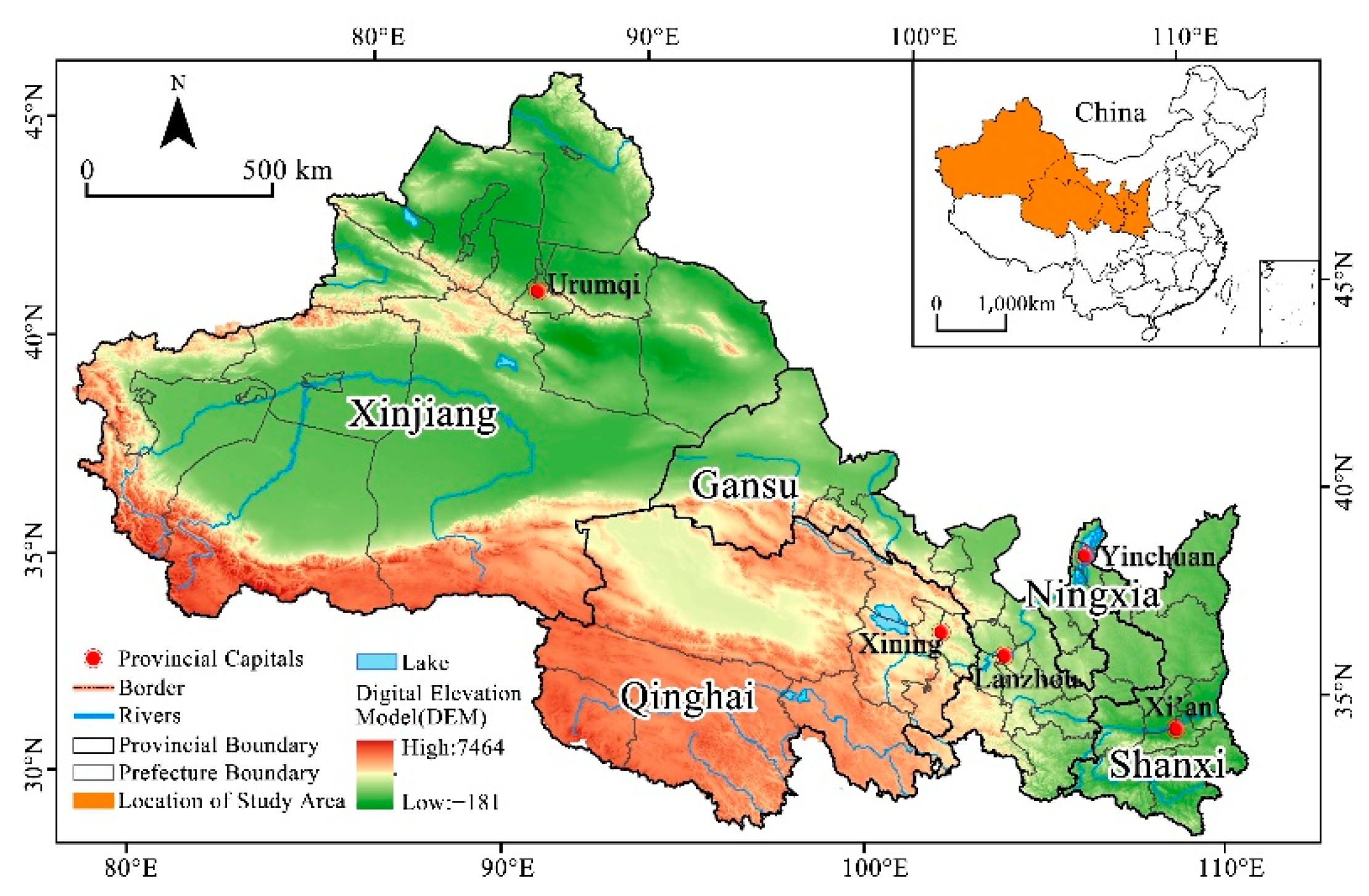

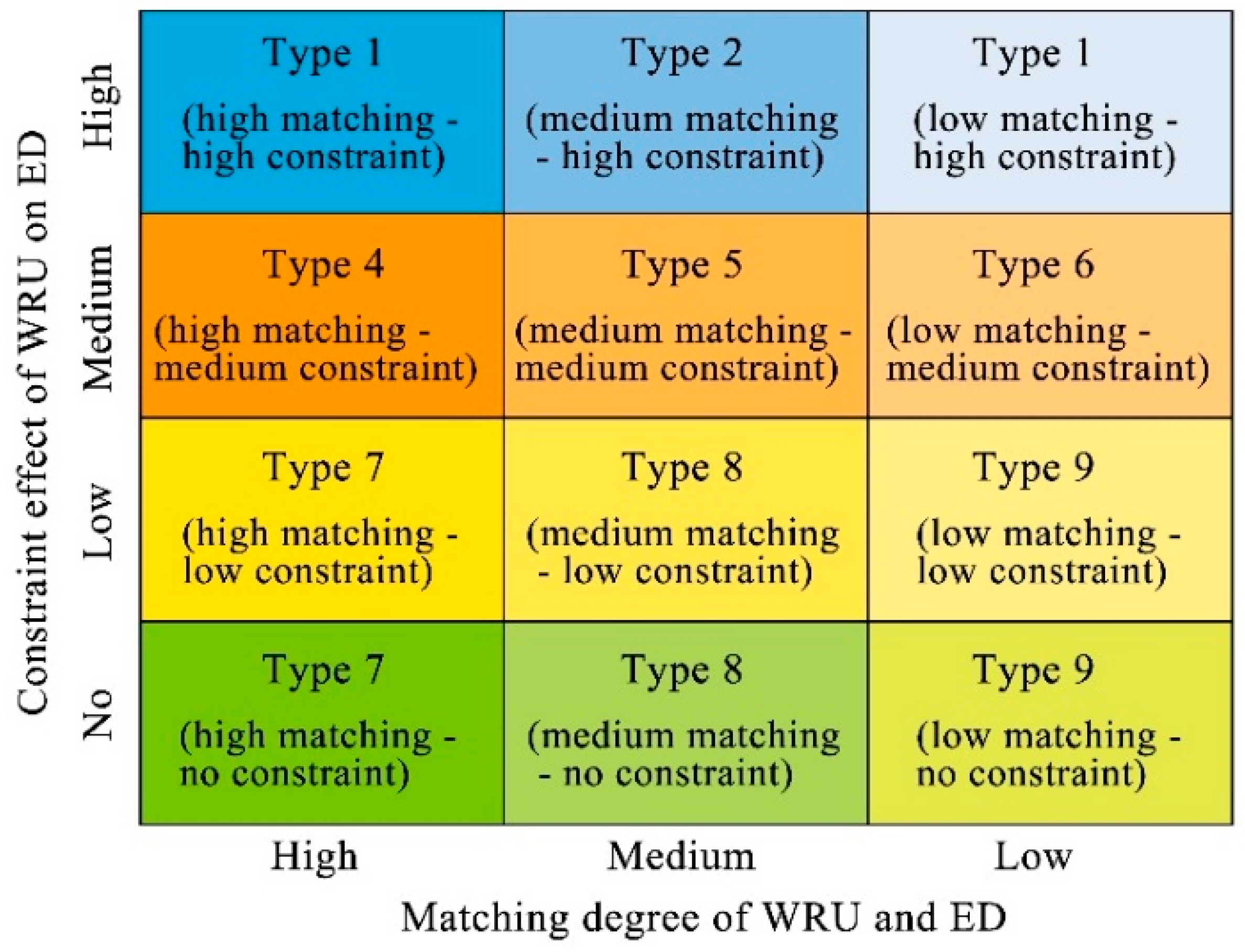

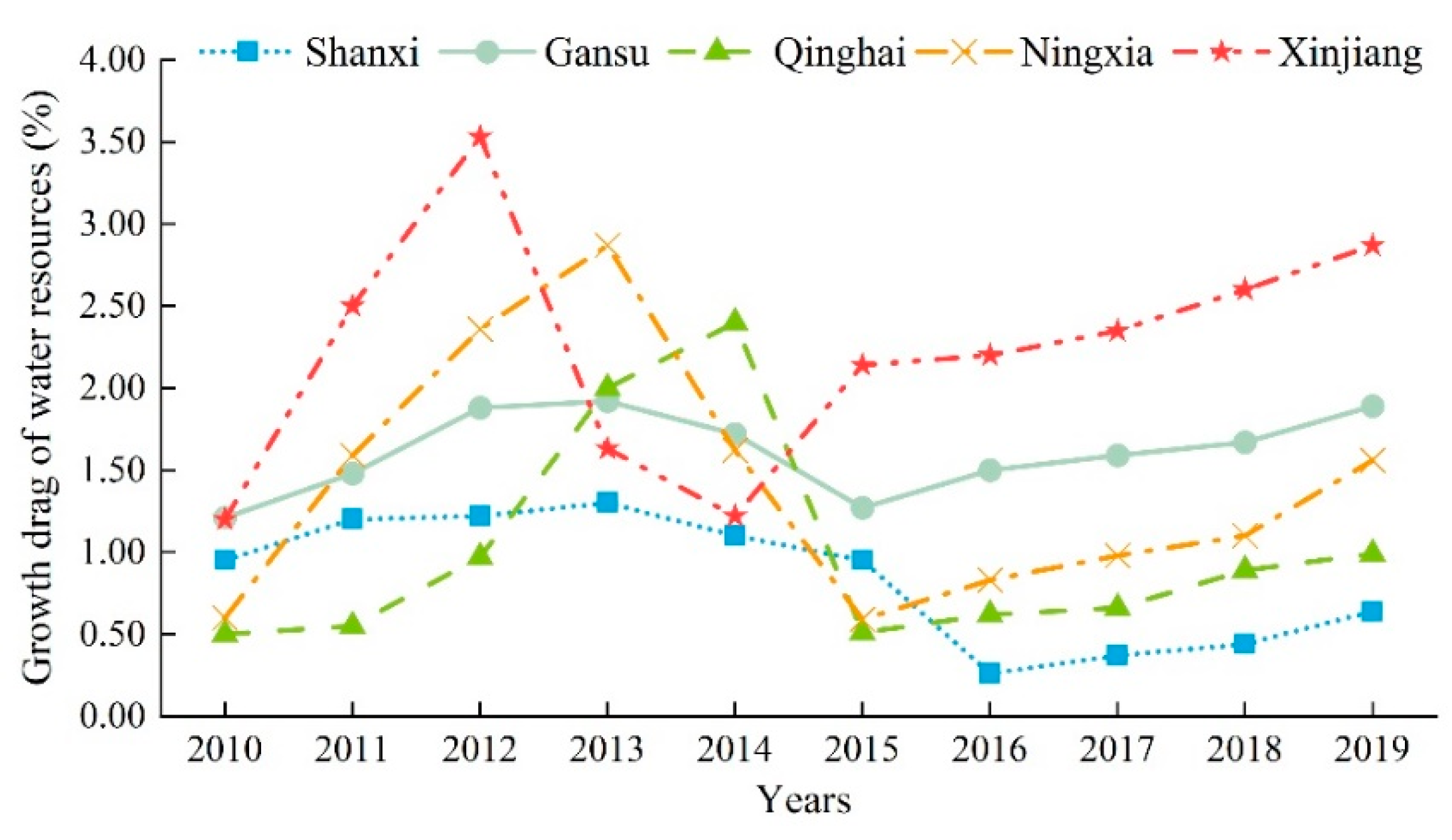
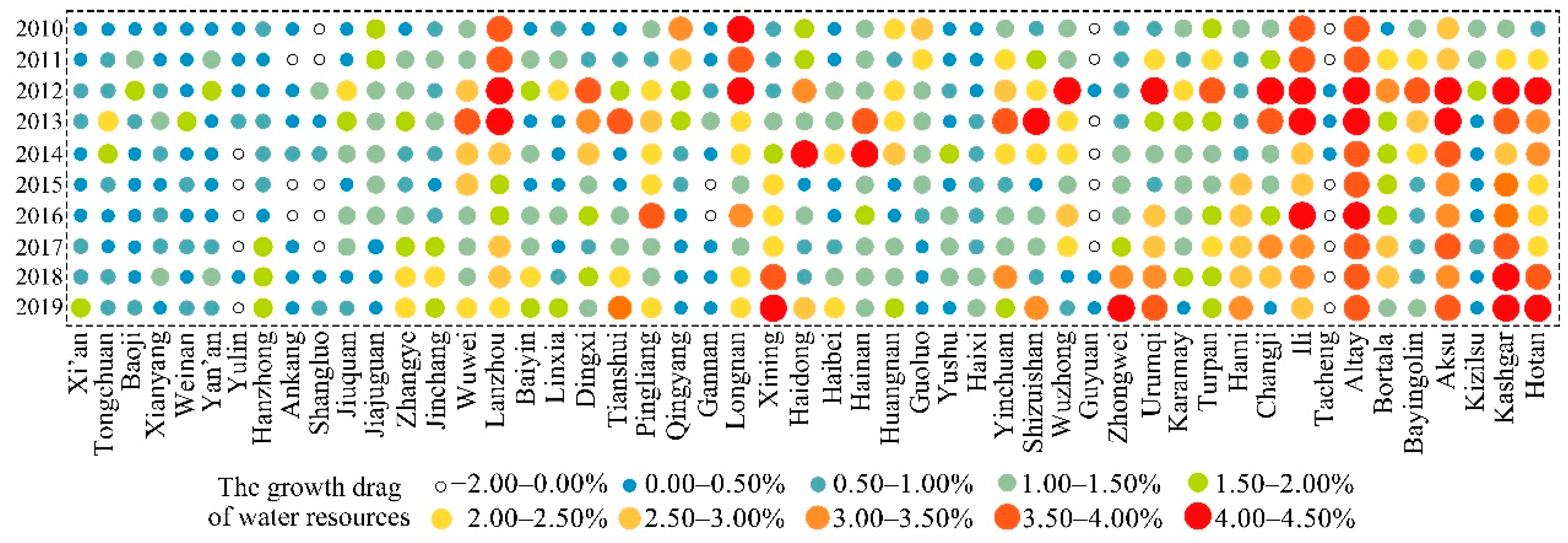


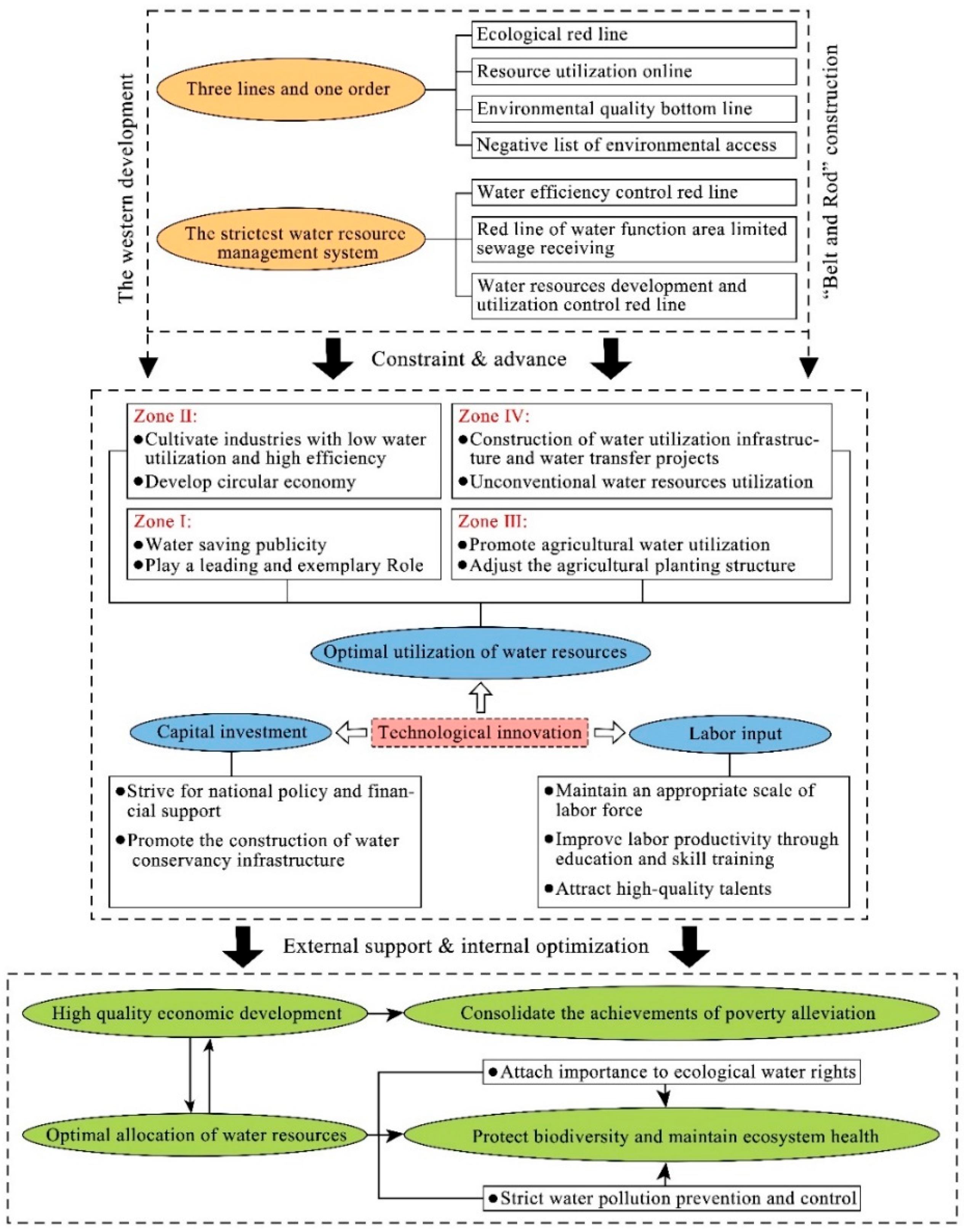
| Regions | 2009 | 2010 | 2011 | 2012 | 2013 | 2014 | 2015 | 2016 | 2017 | 2018 | 2019 | Average |
|---|---|---|---|---|---|---|---|---|---|---|---|---|
| Shaanxi | 0.39 | 0.39 | 0.39 | 0.38 | 0.35 | 0.34 | 0.31 | 0.30 | 0.31 | 0.32 | 0.29 | 0.34 |
| Gansu | 0.44 | 0.44 | 0.45 | 0.46 | 0.48 | 0.48 | 0.49 | 0.49 | 0.50 | 0.50 | 0.52 | 0.48 |
| Qinghai | 0.30 | 0.36 | 0.34 | 0.32 | 0.32 | 0.34 | 0.34 | 0.34 | 0.32 | 0.29 | 0.31 | 0.33 |
| Ningxia | 0.20 | 0.21 | 0.20 | 0.19 | 0.27 | 0.32 | 0.30 | 0.31 | 0.27 | 0.28 | 0.32 | 0.26 |
| Xinjiang | 0.57 | 0.56 | 0.57 | 0.55 | 0.53 | 0.52 | 0.50 | 0.50 | 0.51 | 0.51 | 0.49 | 0.53 |
| Regions | Capital Production Elasticity Coefficient (α) | Labor Production Elasticity Coefficient (1 − α − β) | Water Consumption Production Elasticity Coefficient (β) | R2 |
|---|---|---|---|---|
| Shaanxi | 0.415 ** | 0.314 ** | 0.270 * | 0.984 |
| Gansu | 0.414 ** | 0.370 ** | 0.213 * | 0.990 |
| Qinghai | 0.397 ** | 0.324 ** | 0.274 ** | 0.991 |
| Ningxia | 0.429 ** | 0.369 ** | 0.201 * | 0.988 |
| Xinjiang | 0.377 ** | 0.325 ** | 0.296 ** | 0.992 |
| Constraint Type | Involved Cites |
|---|---|
| No constraint | 1. Yulin; 2. Ankang; 3. Shangluo; 4. Gannan; 5. Guyuan; 6. Tacheng |
| Low constraint | 1. Xi’an; 2. Tongchuan; 3. Baoji; 4. Xianyang; 5. Weinan; 6. Yan’an; 7. Jiayuguan; 8. Jinchang; 9. Baiyin; 10. Linxia; 11. Qingyang; 12. Haibei; 13. Guoluo; 14. Yushu; 15. Haixi; 16. Karamay; 17. Changji; 18. Bayingolin; 19. Kizilsu |
| Medium constraint | 1. Hanzhong; 2. Jiuquan; 3. Zhangye; 4. Wuwei; 5. Dingxi; 6. Tianshui; 7. Pingliang; 8. Xining; 9. Haidong; 10. Hainan; 11. Huangnan; 12. Yinchuan; 13. Shizuishan; 14. Wuzhong; 15. Zhongwei; 16. Urumqi; 17. Turpan; 18. Hami; 19. Bortala |
| High constraint | 1. Lanzhou; 2. Longnan; 3. Ili; 4. Altay; 5. Aksu; 6. Kashgar; 7. Hotan |
Publisher’s Note: MDPI stays neutral with regard to jurisdictional claims in published maps and institutional affiliations. |
© 2022 by the authors. Licensee MDPI, Basel, Switzerland. This article is an open access article distributed under the terms and conditions of the Creative Commons Attribution (CC BY) license (https://creativecommons.org/licenses/by/4.0/).
Share and Cite
Ding, J.; Bai, Y.; Yang, X.; Gao, Z. Spatiotemporal Evolution of Water Resource Utilization and Economic Development in the Arid Region of China: A “Matching-Constraint” Perspective. Sustainability 2022, 14, 8724. https://doi.org/10.3390/su14148724
Ding J, Bai Y, Yang X, Gao Z. Spatiotemporal Evolution of Water Resource Utilization and Economic Development in the Arid Region of China: A “Matching-Constraint” Perspective. Sustainability. 2022; 14(14):8724. https://doi.org/10.3390/su14148724
Chicago/Turabian StyleDing, Junyu, Yongping Bai, Xuedi Yang, and Zuqiao Gao. 2022. "Spatiotemporal Evolution of Water Resource Utilization and Economic Development in the Arid Region of China: A “Matching-Constraint” Perspective" Sustainability 14, no. 14: 8724. https://doi.org/10.3390/su14148724
APA StyleDing, J., Bai, Y., Yang, X., & Gao, Z. (2022). Spatiotemporal Evolution of Water Resource Utilization and Economic Development in the Arid Region of China: A “Matching-Constraint” Perspective. Sustainability, 14(14), 8724. https://doi.org/10.3390/su14148724





